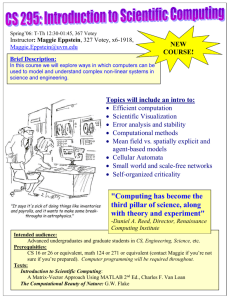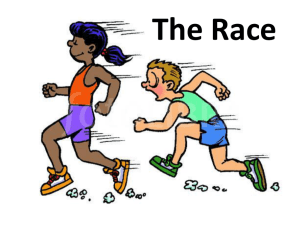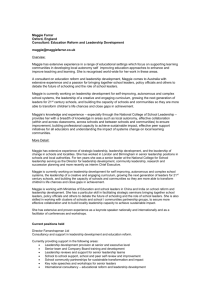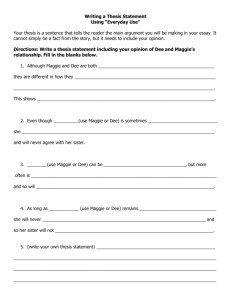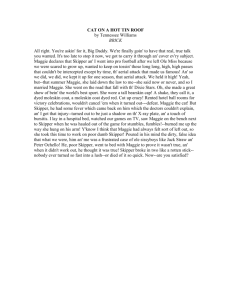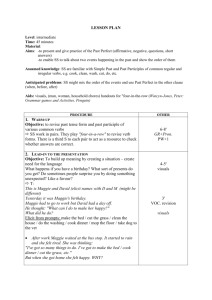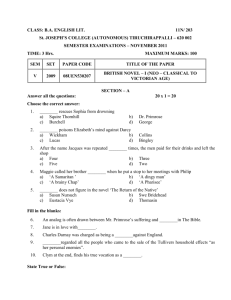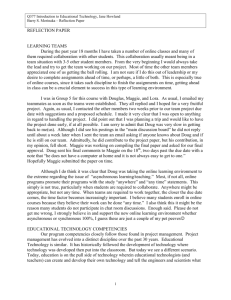Teaching Plans for We Hear the Dead by Dianne K. Salerni
advertisement
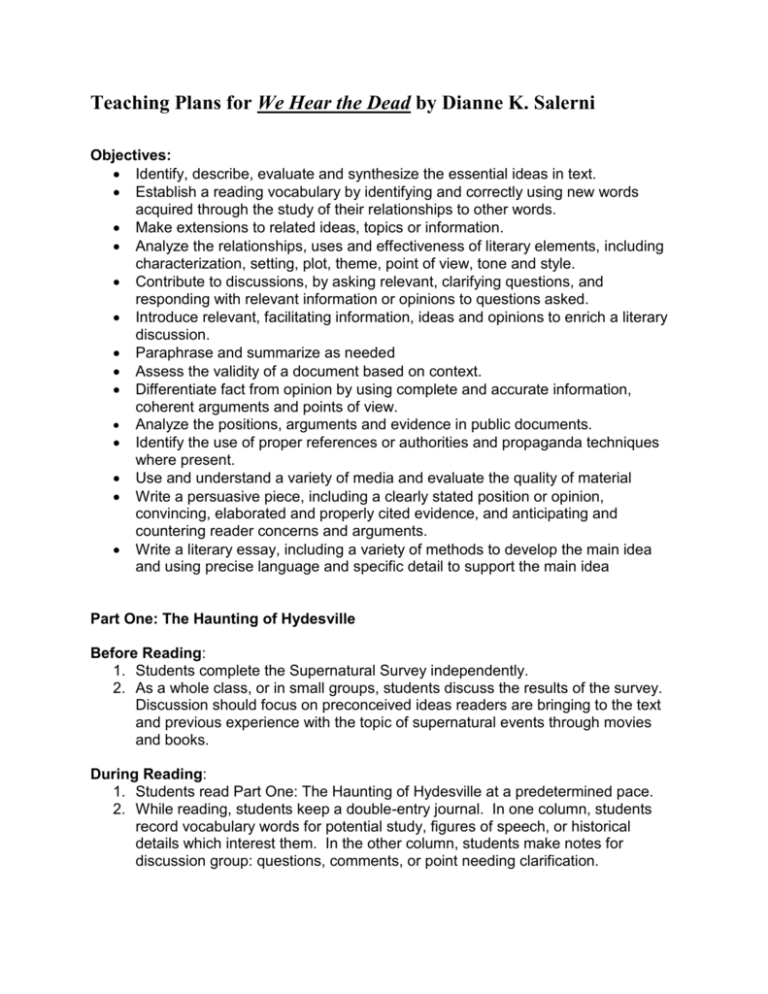
Teaching Plans for We Hear the Dead by Dianne K. Salerni Objectives: Identify, describe, evaluate and synthesize the essential ideas in text. Establish a reading vocabulary by identifying and correctly using new words acquired through the study of their relationships to other words. Make extensions to related ideas, topics or information. Analyze the relationships, uses and effectiveness of literary elements, including characterization, setting, plot, theme, point of view, tone and style. Contribute to discussions, by asking relevant, clarifying questions, and responding with relevant information or opinions to questions asked. Introduce relevant, facilitating information, ideas and opinions to enrich a literary discussion. Paraphrase and summarize as needed Assess the validity of a document based on context. Differentiate fact from opinion by using complete and accurate information, coherent arguments and points of view. Analyze the positions, arguments and evidence in public documents. Identify the use of proper references or authorities and propaganda techniques where present. Use and understand a variety of media and evaluate the quality of material Write a persuasive piece, including a clearly stated position or opinion, convincing, elaborated and properly cited evidence, and anticipating and countering reader concerns and arguments. Write a literary essay, including a variety of methods to develop the main idea and using precise language and specific detail to support the main idea Part One: The Haunting of Hydesville Before Reading: 1. Students complete the Supernatural Survey independently. 2. As a whole class, or in small groups, students discuss the results of the survey. Discussion should focus on preconceived ideas readers are bringing to the text and previous experience with the topic of supernatural events through movies and books. During Reading: 1. Students read Part One: The Haunting of Hydesville at a predetermined pace. 2. While reading, students keep a double-entry journal. In one column, students record vocabulary words for potential study, figures of speech, or historical details which interest them. In the other column, students make notes for discussion group: questions, comments, or point needing clarification. After Reading 1. Students divide into groups for discussion of Part One: The Haunting of Hydesville. 2. The discussion should center on the questions, comments, and clarification points which students have recorded in their reading journals. The following questions can be written on index cards and given to each group to jumpstart discussions if needed: a. Discuss the concept of gullibility. How was it that people could be so easily fooled by what, in retrospect, seems an obvious fraud? b. Maggie claimed to have invented the story of a murdered peddler on impulse. What, then, is the significance of the bones and teeth David found in the basement of the Hydesville house? c. How did the residents of Hydesville contribute to the “snowball effect” of the ghost rapping prank originally conceived by Maggie and Kate? d. David Fox believed that spirit communication was something similar to the telegraph, a scientific advance that only appeared miraculous. Do you believe that any technological or scientific advance could allow us to communicate with the dead? e. Part One ends with Maggie “in a panic” over the arrival of her sister Leah. What do we know of Leah Fish at this point in the story? Speculate on why her presence would cause such a reaction. Extension Activity: 1. Students will read and discuss the examples of e-mail messages on the hand-out Internet Hoaxes. Students may wish to share some examples of similar messages they have received. 2. Students respond to the questions on the hand-out and discuss them in a whole class or small group setting. Background for the teacher: There are numerous variations of each of these examples still circulating on the internet. The medical appeal features variations with different victims needing help, and various benefactors (such as Make-a-Wish or the American Cancer Society) donating pennies for each forwarded message. The call to boycott Starbucks sometimes appears as a call to boycott Oscar Meyer, with the rest of the message remaining the same. The Giveaway message also circulates with small variations in the companies involved or the rewards to be had. If students bring you messages they receive and ask you about their veracity, a good source for you to use is www.snopes.com. This website is an excellent reference for adults to check out possible hoaxes but contains some material that would be inappropriate for student use. The examples on the Internet Hoax worksheet were found on snopes.com. Possible answers to the questions: 1. Similarities include: a request to forward message, original author of message is a stranger, a warning that receiver will regret it if they do not participate. 2. Illogical statements include: a billionaire who offers help but only if the email is forwarded, a national corporation making a political statement which will hurt sales or offering to pay strangers for nothing, the impossibility of tracking the forwarded messages. 3. Possible answers: to see how far the hoax will spread, to profit someone or hurt someone. (Note: the original Beerman message included an e-mail address for the real Carl Beerman. This man eventually lost his internet account because of the hoax, and he claimed the original writer of the message had malicious intent all along.) 4. Possible answers: because it is so easy to forward an e-mail, because they felt guilty ignoring it, because they hoped to get something for nothing. 5. Students may find that it would be awkward to inform the sender of the message that it was a hoax and that it would be better to ignore it than make the sender feel foolish. Other students may feel that they have a duty to counter the hoax. 3. Assign students the task of composing a message which could be sent as a reply when an e-mail hoax has been received. Students may choose one of the given examples, or write a general reply which could be used as a reply to any hoax. The message should be convincing and persuasive, without offending the recipient. 4. Students share their work and comment on the persuasiveness and tact of each one. The class may agree on one good message which they can all use in the future when dealing with internet hoaxes. The Supernatural Survey YES NO 1. Do you believe in ghosts? 2. Do you believe the spirits of the dead can communicate with the living? 3. Do you believe in palm reading or fortune-telling? 4. Do you believe that some people have the psychic ability to read minds or predict the future? 5. Do you believe that some people have the ability to move objects with their minds? 6. Have you ever participated in a professional or amateur séance? 7. Have you ever participated in a professional or amateur session of palm reading or fortune telling? 8. Have you ever experienced a supernatural event? 9. Do you know someone who claims to have experienced a supernatural event? List books, movies, or television shows you have enjoyed which portray supernatural events – whether or not you believe these events could actually happen. Do you have any comment or statement to make regarding ghosts, séances, or other supernatural events? Internet Hoaxes Word of the Hydesville Rapping spread quickly. Each person who was convinced of the haunting was eager to persuade others to believe. In today’s world of the internet, email, and instant messaging, hoaxes spread faster than ever. Carefully read the following e-mail excerpts below. Each one has circulated, with varying details, on the internet for years. Dear Friends My name is Curt Beerman and I live in Charleston, SC. My son Jermaine was recently hit by a car in front of our apartment. Little Jermaine has had many problems with his lungs and right arm since the accident. Our medical costs have become extremely expensive. Jermaine was recently moved to a hospital in Colombia, SC and the move was very expensive. I could not keep my job at the sanitation department because of the move. A billionaire in Georgia has promised to give $0.05 every time this email is forwarded. If you wouldn’t mind forwarding this to everyone on your list, I would greatly appreciate it as well as my son. Your good deeds could really save his life. Please take a few seconds to help us in our time of need. I know how many of these go around and I want you to know they really help. Please have a heart and forward this. Remember: What goes around comes around. Thank you, Curt Beerman Dear everyone: Please pass this along to everyone you know, this needs to get out in the open. Recently, Marines over in Iraq supporting this country in OIF wrote to Starbucks because they wanted to let them know how much they liked their coffee and try to score some free coffee grounds. Starbucks wrote back telling the Marines thanks for their support in the business, but that they don’t support the war or anybody in it and that they won’t send them the coffee. So as not to offend them, we should not support them in buying anymore of their coffee. As a war Vet and writing to you patriots I feel we should get this out in the open. I know this War may not be popular with some folks but that doesn’t mean we don’t support the boys on the ground fighting street to street and house to house for what they believe is right. If you feel the same way I do, then pass this along. If not, then discard it and feel bad every time you buy from Starbucks. Thanks very much for your support. Semper Fidelis Sgt. Howard C. Wright 1st Force Recon Co. To all of my friends, I do not usually forward messages, but this is from my friend who is an attorney and if she says this will work, then it will work! After all, what do you have to lose? Dear Friends: Please do not take this as a junk letter. Bill Gates is sharing his fortune. If you ignore this, you will repent later. Microsoft and AOL are now the largest internet companies and in an effort to make sure that Internet Explorer remains the most widely used program, they are running an email test. When you forward this email, Microsoft can and will track it for a period of two weeks. For every person you forward this to, Microsoft will pay you $245. For every person you forward this to who forwards it on, you will get $243, and for every third person who forwards it on, you will get $241. Within two weeks, Microsoft will contact you and ask for your address and you will get a check. I thought this was a scam myself, but within two weeks of forwarding this email, I received a check for $24,800. If anyone can afford this, it is Bill Gates. This is all marketing expense for him. I know the law, and this is for real. 1. What do all three of the messages have in common? 2. What illogical ideas can you find in the text of each e-mail message which should alert the reader to the hoax? The medical appeal: The Starbucks boycott: The Bill Gates Giveaway: 3. What do you think is the purpose of the original author of these e-mail messages? 4. Why do you think people forward these messages on, perpetuating the hoax? 5. If you receive an e-mail which you believe is a hoax, should you contact the person who sent it to you and let them know they have been fooled? Does your answer to this question change if the sender is … a. Your brother b. Your best friend c. Your wealthy aunt d. Your algebra teacher e. The boss at your summer job? Part Two: The Rise of a Religion Before Reading: 1. Students predict what will happen in the next section of the book, supporting their predictions with evidence. During Reading: 1. Students read Part Two: The Rise of a Religion at a predetermined pace. 2. While reading, students keep a double-entry journal. In one column, students record vocabulary words for potential study, figures of speech, or historical details which interest them. In the other column, students make notes for discussion group: questions, comments, or point needing clarification. After Reading 1. Students divide into groups for discussion of Part Two: The Rise of a Religion. 2. The discussion should center on the questions, comments, and clarification points which students have recorded in their reading journals. The following questions can be written on index cards and given to each group to jumpstart discussions if needed: a. When speaking of how easily she and her sister deceived the newspaper editor Horace Greeley, Maggie comments: “What fools were those men of self-importance, who did not credit two half-grown girls with any cleverness!” How did the common view of females in the nineteenth century work in the favor of the Fox Sisters? Were there any times when it worked against them? b. On more than one occasion, the Fox Sisters were threatened with violence. Why would their claims to spiritual powers provoke some people to violence? c. How does the historical backdrop of this story (mid-nineteenth century America) contribute to the motivations and actions of the characters? d. Are there any professions today which bear a similarity to the one the Fox Sisters created for themselves? e. Compare and contrast the three sisters (Maggie, Kate, and Leah); discuss their personality traits, their motivations, and their perspectives on the clients who come to them for spiritual enlightenment. Extension Project 1. Discuss with the class the concept of “bias.” The lesson should focus on how facts and evidence can be presented in such a way that alternate viewpoints are ignored or devalued. The use of adjectives (ex: alleged, proven, undeniable, miraculous, doubtful) can subtly shade real facts so that they are interpreted in the way the author sees fit. Facts can be left out, or incompletely reported. 2. Students will select a topic related to the supernatural, such as: the Fox Sisters, spiritualism, clairvoyance, ghosts, ufo’s, reincarnation, etc. 3. Students will locate at least four websites on the internet which discuss the chosen site and examine each site for bias. Students will use the Detecting Bias worksheet to: a. Determine the position each website takes on the topic b. Identify the words and phrases which give away the bias of the site c. Identify key arguments used to persuade the reader and/or inadequate arguments which are not convincing to the reader 4. Students will use the information from these websites to write their own article. The teacher can assign students to write with neutrality, write with bias, or (for a challenge) write from the viewpoint opposite the student’s own opinion. Student articles can be compiled into one publication on supernatural phenomena. Detecting Bias Supernatural Topic: _______________________________ Select at least four websites on your topic. Try to find at least one site which demonstrates belief in the topic, one that demonstrates unbelief, and one that demonstrates neutrality. Website URL: ______________________________ Title: ______________________________ This website demonstrates: belief unbelief neutrality List words and phrases from this site that demonstrate bias OR words and phrases which indicate neutrality. List arguments and evidence presented by the website. Mark each one C for convincing or U for unconvincing. Website URL: ______________________________ Title: ______________________________ This website demonstrates: belief unbelief neutrality List words and phrases from this site that demonstrate bias OR words and phrases which indicate neutrality. List arguments and evidence presented by the website. Mark each one C for convincing or U for unconvincing. Website URL: ______________________________ Title: ______________________________ This website demonstrates: belief unbelief neutrality List words and phrases from this site that demonstrate bias OR words and phrases which indicate neutrality. List arguments and evidence presented by the website. Mark each one C for convincing or U for unconvincing. Website URL: ______________________________ Title: ______________________________ This website demonstrates: belief unbelief neutrality List words and phrases from this site that demonstrate bias OR words and phrases which indicate neutrality. List arguments and evidence presented by the website. Mark each one C for convincing or U for unconvincing. Part Three: The Affair and the Adventurer Before Reading: 1. Students predict what will happen in the next section of the book, supporting their predictions with evidence. During Reading: 1. Students read Part Three: The Affair and the Adventurer at a predetermined pace. 2. While reading, students keep a double-entry journal. In one column, students record vocabulary words for potential study, figures of speech, or historical details which interest them. In the other column, students make notes for discussion group: questions, comments, or point needing clarification. After Reading 1. Students divide into groups for discussion of Part Three: The Affair and the Adventurer. 2. The discussion should center on the questions, comments, and clarification points which students have recorded in their reading journals. The following questions can be written on index cards and given to each group to jumpstart discussions if needed: a. How are Maggie and Elisha engaged in “similar professions?” b. Discuss the morality of the Fox Sisters’ fraudulent practices. Elisha says, regarding Maggie: “She has long insisted that her spirit messages do good in the world. I strongly disagree.” Is it possible that good can be accomplished through deception? Or does the means invariably taint the end result? c. Maggie’s romantic interest in Elisha seems natural. He is an upperclass gentleman with a heroic reputation and a charming manner. But what is it about Maggie that arouses Elisha’s romantic interest, when surely he could have his pick of women? d. Leah warns Maggie that her romance with Elisha will come to a bad end. Do you believe she has her sister’s best interests at heart, or is it her own interests she has in mind? In your experience, does anyone who has fallen in love ever heed the romantic advice they are given by another? e. Exploitation is the utilization of another person or group for selfish purposes. Does Leah exploit her sisters for profit? Do Maggie and Kate exploit their clients for fun and amusement? Is Doctor Kane exploiting the mystery of the missing Franklin expedition for fame? Extension Project 1. Students are divided into groups of four or five for the Dinner Party activity. In each group, students should be assigned the roles of Maggie, Kate, Leah, and Elisha. The fifth group member can be assigned another role from the story, such as David Fox, Dr. Langworthy, Mr. Capron, Margaret Fox, etc. This fifth role can be different in each group. 2. In this activity, students will take on their assigned role and pretend they are at a dinner party with the other characters. “Conversation Bombs” will be dropped on the dinner party, and each student should respond as they believe their character would respond. The goal is for the students to ad lib their lines, using their understanding of the characters in the novel as a guide. They may quote from the text, but in most cases they will have to extemporize. 3. Use the “Conversation Bombs” to precipitate discussion between the characters portrayed at the dinner party. Encourage students to let each topic run its course before introducing a new one. Characters should respond not only to the topic, but to each other. They may argue, accuse, defend, lie, and persuade as is deemed appropriate for the character. 4. Students can be evaluated by the teacher using the accompanying rubric, or students may assess each other informally with the student-friendly rubric. 5. As a follow-up activity, students write a brief essay from the point of view of the character they portrayed in the Dinner Party, responding to one of the topics discussed in the activity. Conversation Bombs Cut apart these cards, shuffle them, and introduce them one at a time to the Dinner Party participants. Allow all the characters to express themselves fully and respond to other characters before introducing the next topic. Dr. Kane is not a good match for Maggie. It is wrong to deceive people, even in a good cause. Leah exploits her sisters. Maggie is a fraud, but Kate’s powers are real. Spirit communication is a Kate is delusional, thanks to her scientific discovery, just like the addiction to a morphine-laced telegraph. tonic. Arctic exploration is a waste of money and resources. Respectability is one of the most important characteristics a person can have. Dinner Party Evaluation As a group, discuss and evaluate each person’s participation level. Use the following designations: 1. Don’t Call Us; We’ll Call You! (Needs more conversation practice to fully respond and participate.) 2. In Line for Casting Call (Participates in conversation, needs more practice to stay in character.) 3. Ready for Improv (Full participation and good understanding of characters with responses that match the text.) 4. True Spirit Medium (Eerily accurate portrayal of assigned character, genius or paranormal activity at work!) Participant: Maggie, played by Kate, played by Leah, played by Elisha, played by _________, played by Score: Positive Feedback: Evaluation Rubric for We Hear the Dead: The Dinner Party Name of Student ______________________ Performance Benchmark Contributed to discussion, by responding with relevant information or opinions. Listened to and acknowledged the contributions of others. Always Date _________ Usually Rarely Demonstrated the ability to synthesize and express the essential ideas in the text. Demonstrated an understanding of literary elements, including characterization, theme, and point of view. Made extensions to the information in the text in order to respond appropriately to the topic. Evaluation Rubric for We Hear the Dead: The Dinner Party Name of Student ______________________ Performance Benchmark Contributed to discussion, by responding with relevant information or opinions. Listened to and acknowledged the contributions of others. Demonstrated the ability to synthesize and express the essential ideas in the text. Demonstrated an understanding of literary elements, including characterization, theme, and point of view. Made extensions to the information in the text in order to respond Always Date _________ Usually Rarely appropriately to the topic. Part Four: Education and Exile Before Reading: 1. Students predict what will happen in the next section of the book, supporting their predictions with evidence. During Reading: 1. Students read Part Four: Education and Exile at a predetermined pace. 2. While reading, students keep a double-entry journal. In one column, students record vocabulary words for potential study, figures of speech, or historical details which interest them. In the other column, students make notes for discussion group: questions, comments, or point needing clarification. After Reading 1. Students divide into groups for discussion of Part Four: Education and Exile. 2. The discussion should center on the questions, comments, and clarification points which students have recorded in their reading journals. The following questions can be written on index cards and given to each group to jumpstart discussions if needed: a. At times, Maggie has demonstrated a willfulness and independence of spirit. Why then has she been repeatedly led by others (Kate, Leah, and Elisha) into a way of life she would not have chosen for herself? b. In your opinion, what is the greatest obstacle to happiness for Maggie and Elisha? c. What, if anything, did Maggie gain from her two years spent in virtual exile from her family? d. Kate believes that she has a special power. Does Maggie believe in Kate’s power? e. How were the standards of behavior for women in the mid-nineteenth century different from the standards of behavior for men? Extension Project: 1. Students will page back through the double-entry journal they have been keeping since the beginning of the book and make a list of suitable vocabulary words for study. 2. Students will research the meaning of the selected words, using dictionaries, thesauruses, and the context in which the word was used. Students may record their findings in any manner which suits them, although the teacher may suggest the use of a web, such as the one included in these plans. 3. Working together in groups of two or three, students will use some of the vocabulary words on their lists to create analogy puzzles. surcease : suspension : : animosity : _______________ a. grief b. malice c. kindliness d. disbelief 4. Students may require some instruction on creating and solving analogies. Discuss with students the types of word relationships which may be discovered between the first two words, including: synonyms, antonyms, descriptive, part to whole, item to category, etc… 5. Having selected a relationship between two words, a second pair of words is chosen with the same relationship. One of the words is removed from the analogy and included with a group of incorrect, but plausible words. Access to an online dictionary/thesaurus would be very advantageous for this activity. The relationship of remedy and illness has been chosen for the following analogy: antibiotic : infection : : antiscorbutic : ________________ Several words have been chosen for the multiple choice answers, including illnesses and words that are related to the topic, but do not match the selected relationship. a. consumption b. vitamin C c. scurvy 6. Students exchange and solve each others’ analogy puzzles. d. medicine Word Web Analogies Use the vocabulary words you have studied to create analogies. In an analogy, the relationship between the first two words is used to identify the missing word in the second pair. To create an analogy, select a vocabulary word you wish to use and a relationship to build the analogy. Replace one word from the second pair with a blank and add three false answers. Vocabulary word: surcease Relationship: synonyms surcease : suspension : : animosity : _______________ a. grief Vocabulary word: antiscorbutic b. malice c. kindliness d. disbelief Relationship: remedy and illness antibiotic : infection : : antiscorbutic : ________________ a. consumption b. vitamin C c. scurvy d. medicine ___________ : ___________ : : ____________ : ___________ a. b. c. d. ___________ : ___________ : : ____________ : ___________ a. b. c. d. ___________ : ___________ : : ____________ : ___________ a. b. c. d. Part Five: Folly and Fate Before Reading: 1. Students predict what will happen in the next section of the book, supporting their predictions with evidence. During Reading: 1. Students read Part Five: Folly and Fate at a predetermined pace. 2. While reading, students keep a double-entry journal. In one column, students record vocabulary words for potential study, figures of speech, or historical details which interest them. In the other column, students make notes for discussion group: questions, comments, or point needing clarification. After Reading 1. Students divide into groups for discussion of Part Five: Folly and Fate. 2. The discussion should center on the questions, comments, and clarification points which students have recorded in their reading journals. The following questions can be written on index cards and given to each group to jumpstart discussions if needed: a. Discuss the manner in which Kate Fox has grown up. In what ways does she bear a similarity to child stars of the twentieth and twenty-first century? b. In the final chapter, Maggie asks herself if there was a point where she could have “put her foot down upon some other path” and created a happier future. In your opinion, how could she have avoided her fate? What actions or decisions could have changed the outcome of her life? c. Which of the three Fox Sisters do you think was the most self-absorbed? If the sisters were asked this question, how might each one respond? d. Elisha Kent Kane sought to expand man’s knowledge of the world through his explorations. The Fox Sisters created a profession that gave women a voice in their society and inspired a fascination with the supernatural that outlived them. Which legacy was the greater one? e. Did the information on the last page of the novel change your perception of the events of the book? Extension Activity 1. Discuss with students the difference between three-dimensional or complex characters with multiple character traits and one-dimensional or flat characters. Focus on such characters as Maggie (willful, mischievous, but easily led by others), Leah (manipulative, shrewd, but capable of inspiring love and loyalty), and Elisha (physically brave but emotionally weak). 2. Assign the students to write a literary essay about one character from We Hear the Dead with a complex nature. The essay should describe the traits which make the character complex and supply supporting evidence from the text. 3. At teacher discretion, advanced students may be given a more difficult assignment. Students could be assigned to write a literary essay on the setting of the book (antebellum America, in an age of social reform and lecture halls) or the themes of the book (deception, family loyalty, fate, women’s role in society).
